|
 Secure Site
Secure Site
|
 |
Archive for the 'intention' Category
 yoga to calm your mind Yoga is a great way to deal with stress—and research backs it up. According to a recent study by the Boston University School of Medicine, any variety of yoga may increase brain levels of the neurotransmitter gamma-aminobutyric acid (GABA), which is associated with relaxation and lowered anxiety. If you’re struggling with an anxiety disorder, try easing it with restorative yoga—the kind that uses pillows or blankets to support your body and allow you to relax deeply in every pose.
A good source for restorative poses is Relax and Renew: Restful Yoga for Stressful Times (Rodmell Press, 1995) by Judith Hanson Lasater. Other helpful poses, says Bo Forbes, founder of the Boston-area Center for Integrative Yoga Therapeutics, include Supported Child’s Pose and Supported Reclining Twist. Practice in a dim, quiet room to cut down on sensory stimulation, and use two-to-one breathing: exhaling for twice as long as you inhale.
For even better results, follow your restorative practice with eight to ten minutes of relaxed, even breathing from your diaphragm (be sure to set your Zen Yoga Timer so that you know when to end your practice), suggests yoga expert Rolf Sovik, Psy.D., director of the Himalayan Institute in Buffalo, N.Y., and author of Moving Inward: The Journey to Meditation (Himalayan Institute Press, 2005). “Breathing calms the nervous system and decreases the impact of anxiety.”
The perfect position for relaxed breathing is Crocodile Pose, Sovik adds. If you have a blanket, roll it into a “Tootsie Roll” shape, fold that into a long horseshoe, and prop it so when you lie on it, chest down, the round end is under your chin and the sides are propping up your chest. A pillow can go under your forehead. This should allow your abdomen to remain relaxed, your lower back to rise and fall, and your rib cage to move freely. Set your Yoga Timer from Now & Zen to chime in five minutes and continue your breathing until it sounds.
adapted from Natural Solutions Magazine, November 2007 by Ben Kallen
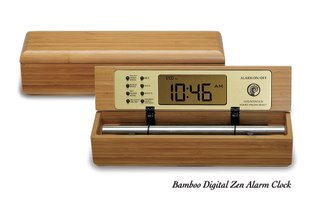 Zen Yoga Timer in Bamboo with Natural Acoustic Chime Our Yoga Timer with Chime also serves as a countdown and interval timer for yoga, meditation, bodywork, etc.; and it can also be set to chime on the hour as a tool for “mindfulness.”
Now & Zen’s Yoga Timer Store
1638 Pearl Street
Boulder, CO 80302
(800) 779-6383
Posted in intention, mindfulness practice, Well-being, yoga, Yoga Timer, Yoga Timers by Now & Zen
 energizing yoga It’s three o’clock, and despite your novel-length to-do list, the only thing that holds your attention longer than 30 seconds is the thought of a caffeine or sugar fix. You’d get a better and more sustained boost, though, by practicing a midday meditation.
Typically associated with relaxation, meditation also jump-starts energy and clears a foggy head, says Eric Harrison, director of Australia’s Perth Meditation Centre and author of “Flip the Switch: 40 Anytime, Anywhere Meditations in 5 Minutes or Less.” “If you meditate consciously and don’t succumb to sleep, your mind becomes calm and clear,” he explains. And unlike the usual drowsiness cures, a few minutes of meditation can keep you alert all afternoon.
One of Harrison’s favorite quick meditations involves tuning in to the sounds we generally try to ignore, which gives the chattering mind a chance to rest. So close your office door or find a quiet space and follow these easy steps — and that cafe run might soon be a thing of the past.
 yoga at work Listening Meditation
Clear a space. Set your Zen Meditation Timer for 5 minutes. Take a moment to remove some of the clutter in your immediate area — mugs, scattered pens, loose papers. This helps you transition into meditation mode and sets the stage for a calmer, more productive afternoon.
Log off. Turn off your computer and silence the ringers on your work and cell phones. This limits physical distractions while freeing up your mind to focus on listening.
Close your eyes and normalize your breathing. Sit up straight and take long, deep, deliberate inhalations, followed by even longer exhalations. Continue this breathing throughout the entire exercise.
Begin listening. Tune in to the sounds around you as if you were listening to music. Let your ears explore both background and foreground noises. Are there any sounds you can hear now that you didn’t before? What’s the most distant sound you can hear? What’s the closest? What music or harmonies do they create together?
Notice your mood. Suspend any judgments about the sounds that normally irritate you, like the hum of the copier, and just listen.
Check your body. Locate any tense feelings within, and concentrate on relaxing each one of them.
When you hear the Zen Meditation Timer Chime, after several minutes, open your eyes. Notice the difference in your energy level. If you’re still feeling groggy, distracted, or unfocused, continue the listening meditation for a minute or two more.
adapted from Body + Soul, June 2007 by Donna Garlough
 maple zen timer for meditation and yoga
Now & Zen
1638 Pearl Street
Boulder, CO 80302
(800) 779-6383
Posted in Bamboo Chime Clocks, intention, Meditation Timers, Meditation Tools, mindfulness practice, Now & Zen Alarm Clocks, Well-being
 meditation improves attention New research shows that meditation can help you improve your ability to concentrate in two ways. First, it can make you better at focusing on something specific while ignoring distractions. Second, it can make you more capable of noticing what is happening around you, giving you a fuller perspective on the present moment.
Some of the most fascinating research on how meditation affects attention is being conducted by Antoine Lutz, PhD, an associate scientist at the Waisman Laboratory for Brain Imaging and Behavior at the University of Wisconsin at Madison, in collaboration with Richard Davidson and the Laboratory for Affective Neuroscience at the University of Wisconsin. Their work has shown that concentration meditation, in which the meditator focuses complete attention on one thing, such as counting the breath or gazing at an object, activates regions of the brain that are critical for controlling attention. This is true even among novice meditators who receive only brief training. Experienced meditators show even stronger activation in these regions. This you would expect, if meditation trains the brain to pay attention. But extremely experienced meditators (who have more than 44,000 hours of meditation practice) show less activation in these regions, even though their performance on attention tasks is better. The explanation for this, in Lutz’s view, is that the meditation training can eventually help reduce the effort it takes to focus your attention. “This would be consistent with traditional accounts of progress in meditation practice. Sustaining focus becomes effortless,” Lutz says. This suggests that people can immediately enhance concentration by learning a simple meditation technique, and that practice creates even more progress.
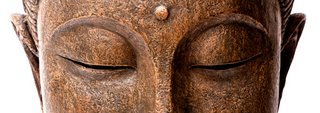 Buddha The researchers also looked at whether vipassana meditation training can improve overall attention. (Vipassana means “to see things as they really are,” and the meditation techniques are designed to increase focus, awareness, and insight.) Researchers label our inability to notice things in our environment as “attentional blink.” Most of us experience this throughout the day, when we become so caught up in our own thoughts that we miss what a friend says to us and have to ask her to repeat it. A more dramatic example would be a car accident caused by your thinking about a conversation you just had and not noticing that the car in front of you has stopped. If you were able to reduce your attentional blink, it would mean a more accurate and complete perception of reality—you would notice more and miss less.
To test whether meditation reduces attentional blink, participants had to notice two things occurring in rapid succession, less than a second apart. The findings, published in PLoS Biology, reveal that the meditation training improved the participants’ ability to notice both changes, with no loss in accuracy.
What explained this improvement? EEG recordings—which track patterns of electrical activity in the brain, showing precise moment-by-moment fluctuations in brain activation—showed that the participants allocated fewer brain resources to the task of noticing each target. In fact, the meditators spent less mental energy no-ticing the first target, which freed up mental bandwidth for noticing what came next. Paying attention literally became easier for the brain.
As a result, Lutz and his colleagues be-lieve that meditation may increase our control over our limited brain resources. To anyone who knows what it’s like to feel scattered or overwhelmed, this is an ap-pealing benefit indeed. Even though your attention is a limited resource, you can learn to do more with the mental energy you already have.
adapted from Yoga Journal, by Kelly McGonigal
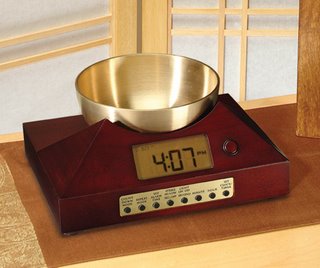 Zen Timepiece with brass singing bowl, a meditation timer Now & Zen
1638 Pearl Street
Boulder, CO 80302
(800) 779-6383
Posted in Bamboo Chime Clocks, intention, Meditation Timers, Meditation Tools, mindfulness practice, Now & Zen Alarm Clocks, Well-being, Yoga Timer
 Meditation Practice, Stillness of Being For a formal practice to cultivate equanimity, begin with some calming breaths or a mantra meditation. Once you feel calm, reflect on your desire for happiness and freedom from suffering, both for yourself and for others. Contemplate your desire to serve the needs of others and to be compassionately engaged in the world. Acknowledge both the joy and the suffering that exist throughout the world—the good deeds and the evil ones. As you continue to breathe into your heart’s center, acknowledge the necessity of balancing your desire to make positive change in the world with the reality that you cannot control the actions of others.
Bring to mind the image of someone for whom you have no strong feelings one way or the other. With this person in your mind’s eye, repeat the following phrases to yourself, coordinating with the outbreath if you like:
- All beings like yourself are responsible for their own actions.
- Suffering or happiness is created through one’s relationship to experience, not by experience itself.
- Although I wish only the best for you, I know that your happiness or unhappiness depends on your actions, not on my wishes for you.
- May you not be caught in reactivity.
Feel free to use other similar, appropriate phrases of your own devising. After a few minutes, shift your attention to your benefactors, including teachers, friends, family and the unseen workers who keep the societal infrastructure working. Silently repeat the phrases to yourself as you contemplate these benefactors.
After several minutes, begin to reflect on your loved ones, directing the phrases to them, followed by the difficult people in your life. While feeling kindness, compassion, and joy for those we love comes more easily than it does for those with whom we have difficulty, it is often the opposite with equanimity. It’s a lot easier to accept that those we dislike are responsible for their own happiness than it is for those we care for deeply, because we feel more attachment to them. Whatever your experience, simply note any reactivity and see if you can be equanimous with your reactivity! Broaden your reach after a few minutes to include all beings everywhere throughout the world, and then finally contemplate equanimity in regard to yourself, noticing how taking responsibility for your own happiness and unhappiness can feel the hardest of all.
- All beings, including myself, are responsible for their own actions.
- Suffering or happiness is created through one’s relationship to experience, not by experience itself.
- Although I wish only the best for myself, I know that my happiness or unhappiness depends on my actions, not my wishes for myself.
- May I not be caught in reactivity.
adapted from Yoga Journal by Frank Boccio
Frank Jude Boccio is a teacher of yoga and Zen Buddhism and the author of Mindfulness Yoga. Find him at mindfulnessyoga.net.
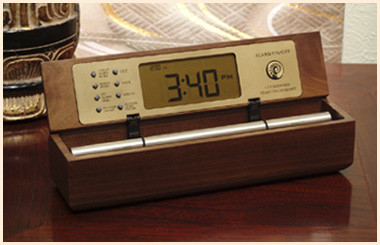 Meditation Timer for Your Meditation Practice The Walnut Digital Zen Clock’s long-resonating Tibetan bell-like chime makes waking up and meditating a beautiful experience – its progressive chimes begin your day with grace. When the clock’s alarm is triggered, the acoustic chime bar is struck just once … 3-1/2 minutes later it strikes again … chime strikes become more frequent over 10 minutes … eventually striking every 5 seconds until shut off. As they become more frequent, the gentle chimes will always wake you up or bring you out of your meditation. Your body really doesn’t need to be awakened harshly, with a Zen Clock you’re awakened more gradually and thus more naturally. Unlike artificial recorded sounds coming out of a tiny speaker in a plastic box, natural acoustic sounds transform your bedroom or office environment.
The Digital Zen Clock also serves as a countdown and interval timer for yoga, meditation, bodywork, etc.; and it can also be set to chime on the hour as a tool for “mindfulness.”
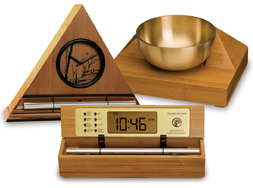 Find the Entire Family of Meditation Timer and Gongs at Now & Zen's Store in Boulder Now & Zen’s Meditation Timer Store
1638 Pearl Street
Boulder, CO 80302
(800) 779-6383
Posted in intention, Meditation Timers, Meditation Tools, mindfulness practice, Well-being, Zen Timers
 Try a Listen Meditation as a Mindfulness Practice Listening Meditation
Instructor Sally Kempton is a spiritual guide who teaches yoga and meditation at her Carmel, Calif.-based Awakened Heart Meditation (sallykempton.com). She authored The Heart of Meditation under her monastic name Swami Durgananda.
What is it? While many meditation techniques require solitude and silence, this one has you engage with the sounds all around you; it invites you to work with and use the noise instead of fighting it. Listening meditation also encourages you to harmonize with your surroundings, and, by extension, the universe. The intent is to experience sound as vibration, rather than information. The listening practice is a way of interacting with the environment that allows you to take in the whole energy of the present moment, says Kempton.
What’s it good for? Especially adaptable and portable, listening meditation can be practiced in crowded, noisy situationson a bus, at the office that would be hard on other styles. (Kempton once led a listening meditation workshop in the middle of a busy Whole Foods store!) People with particularly chattering minds may need to couple this practice with a mantra or breathing meditation. However, many people welcome the chance to focus outward rather than inward and find that listening meditation is one of the easier techniques to undertake. You’ll come away from it feeling refreshed, expanded, and at ease with your environment, declares Kempton.
How long does it take? Try for five minutes at first, then add a minute or two until you can do it for 15 or 20 minutes at a time. Set your Chime Meditation Timer by Now & Zen for five minutes and then increase as you get better at this practice.
How Do I Do It?
1. Set your Meditation Chime Timer for 5 minutes (increase the minutes as you improve). Sit in a comfortable position and close (or half close) your eyes.
2. To get centered and quiet the mind, first bring your awareness to your breath, noticing but not trying to change it.
3. Now open your ears and bring your awareness to the sounds around you. The goal is to listen to the whole range of sounds, without favoring one over another and without identifying them. Hear the quiet sounds and the silences as well as the dominant sounds.
4. When you find yourself identifying sounds (there’s a fire engine; thats the cat scratching the rug), gently redirect your attention from listening to a specific noise back to hearing the whole spectrum of sounds.
5. To end, slowly open your eyes, stand, and carry this heightened awareness with you for as long as you can.
Tip: Do a one-minute mini-listening meditation while standing in line or sitting at your desk, or anytime you feel frazzled: Close your eyes, breathe, and listen to the sounds around you. Like the practice of counting to 10 when you’re in the heat of an argument, this will help you pause, center, and regroup.
 Zen Meditation Timers, The Digital Zen Alarm Clock in Solid Walnut adapted from Natural Health Magazine
Now & Zen’s Chime Time Store
1638 Pearl Street
Boulder, CO 80302
(800) 779-6383
Posted in Bamboo Chime Clocks, Chime Alarm Clocks, intention, Meditation Timers, Meditation Tools, mindfulness practice, Well-being, Zen Timers
 It's exquisite sounds summon your consciousness out of your meditative state with a series of subtle gongs. Once you experience the Zen Timepiece's progressive tones, you'll never want to meditate any other way. It serves as the perfect meditation timer. Set aside 30 minutes, preferably at the end of the day, to try this Naikan practice.
Sitting comfortably, with eyes closed, take a few moments to bring attention to your breath, mantra, or any other technique that you normally use to center yourself. When you feel settled, ask yourself this series of questions:
What have I received today?
Be specific and reflect on as many things as you can recall. It can be something as simple as your partner’s smile, the sound of a bird singing at dawn, the driver who let you merge into the crowded freeway. Remember, the motivation or attitude of those who gave you something is not the issue. Maybe you were offered lunch because you showed up at lunchtime, not because your friend made a personal effort to make you lunch. The fact is, you were fed, and you can feel gratitude for that. The mere fact that you benefited from someone’s actions is all that is needed to cultivate gratitude.
Notice which of these things you did not appreciate as they happened. Can you recall what was taking your attention when one of these acts of grace occurred? Were you stuck in problem-solving mode, thinking of your to-do list, or making judgments?
We often live as if the world owes us. As you reflect on what you have been given today, you will likely see that, if anything, you owe the world an insurmountable debt. This insight is more than merely humbling; you may find yourself feeling a deeper sense of gratitude and a natural desire to be generous in serving others.
What have I given today?
 This unique "Zen Clock" features a long-resonating acoustic chime that brings the meditation session to a gradual close, preserving the environment of stillness while also acting as an effective time signal. Go through the day’s events in the same way, but this time notice what you have given to others. Be as specific and concrete as possible. As above, your motivation is irrelevant. What did you actually do? It may have been as simple as feeding your cats, washing the breakfast dishes, or sending a friend a birthday card. You may find that without great fanfare you contribute to the well-being of many people and animals—you make a positive difference to the planet.
What difficulties and troubles did I cause today?
Again, be specific. Don’t overlook the seemingly insignificant. Your list may include things like “I backed up traffic while looking for a place to park” or “I chased the cats off the lounge chair so I could sit there.” This question is often the hardest, but its importance cannot be overstated. It may bring up feelings of remorse, but its primary purpose is to provide a more realistic view of your life.
 Now & Zen’s mission is to participate in the emerging movement in society toward a more spiritually focused lifestyle. In general, we are all too aware of how others cause us inconvenience or difficulty, but rarely do we notice when we are the source of inconvenience. And if we do, we usually brush it aside as an accident, not that big a deal, or simply something we didn’t mean to do. We cut ourselves a huge length of slack! But seeing how you cause others difficulty can deflate your ego while reminding you again of the grace by which you live.
These questions provide the framework for reflecting on all your relationships, including those with family, friends, co-workers, partners, pets, and even objects. You can reflect on the events of one day, a specific person over the course of your relationship, or a holiday visit with family.
Remember, what makes this a meditative practice is that you are not analyzing your motivations or intentions; you are not interpreting or judging. You are simply shifting your attention from self-centered thinking to seeing things as they are, and as all yoga traditions point out, in seeing, there is wisdom and liberation.
adapted from Yogajournal.com by By Frank Jude Boccio
Although meditation can be done in almost any context, practitioners usually employ a quiet, tranquil space, a meditation cushion or bench, and some kind of timing device to time the meditation session. Ideally, the more these accoutrements can be integrated the better. Thus, it is conducive to a satisfying meditation practice to have a timer or clock that is tranquil and beautiful. Using a kitchen timer or beeper watch is less than ideal. And it was with these considerations in mind that we designed our digital Zen Alarm Clock and practice timer. This unique “Zen Clock” features a long-resonating acoustic chime that brings the meditation session to a gradual close, preserving the environment of stillness while also acting as an effective time signal. The Digital Zen Clock can be programmed to chime at the end of the meditation session or periodically throughout the session as a kind of sonic yantra. The beauty and functionality of the Zen Clock/Timer makes it a meditation tool that can actually help you “make time” for meditation in your life.
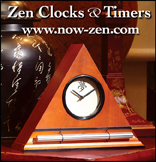 Now & Zen’s mission is to participate in the emerging movement in society toward a more spiritually focused lifestyle.
 Rather than an artificial recorded sound played through a speaker, the Zen Clock features an alloy chime bar similar to a wind chime. Now & Zen – The Meditation Timer Shop
1638 Pearl Street
Boulder, CO 80302
(800) 779-6383
Orders@now-zen.com
Posted in intention, Meditation Timers, Meditation Tools, mindfulness practice
 meditation Science has proven that meditating actually restructures your brain and can train it to concentrate, feel greater compassion, cope with stress, and more. Read the latest research and put it into practice.
Yoga citta vritti nirodhah. Yoga is the ending of disturbances of the mind. (Yoga Sutra, I.2)
Nothing is quite as satisfying as a yoga practice that’s filled with movement. Whether you prefer an intense and sweaty vinyasa practice, a gentle but deliberate Viniyoga practice, or something in between, all systems of hatha yoga provide a contented afterglow for the same reason: You sync your movement with your breath. When you do, your mind stops its obsessive churning and begins to slow down. Your attention turns from your endless to-do list toward the rhythm of your breath, and you feel more peaceful than you did before you began your practice.
For many of us, accessing that same settled, contented state is more difficult to do in meditation. It’s not easy to watch the mind reveal its worries, its self-criticism, or its old memories. Meditation requires patience and—even more challenging for most Westerners—time. So, why would you put yourself through the struggle?
Quite simply, meditation can profoundly alter your experience of life. Thousands of years ago the sage Patanjali, who compiled the Yoga Sutra, and the Buddha both promised that meditation could eliminate the suffering caused by an untamed mind. They taught their students to cultivate focused attention, compassion, and joy. And they believed that it was possible to change one’s mental powers and emotional patterns by regularly experiencing meditative states. Those are hefty promises.
But these days, you don’t have to take their word for it. Western scien-tists are testing the wisdom of the masters, using new technology that allows researchers to study how meditation in-fluences the brain.
The current findings are exciting enough to encourage even the most resistant yogis to sit down on the cushion: They suggest that meditation—even in small doses—can profoundly influence your experience of the world by remodeling the physical structure of your brain.
Our Zen Timepiece’s acoustic 6-inch brass bowl-gong clock is the world’s ultimate alarm clock, practice timer, and “mindfulness bell.”
It fills your environment with beautifully complex tones whenever it strikes. In the morning, its exquisite sounds summon your consciousness into awakening with a series of subtle gongs that provide an elegant beginning to your day. Once you experience the Zen Timepiece’s progressive awakening, you’ll never want to wake up any other way. It also serves as the perfect meditation timer.
adapted from Yoga Journal, By Kelly McGonigal
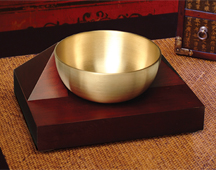 Meditation Timers with Tibetan-Singing Bowls Now & Zen
1638 Pearl Street
Boulder, CO 80302
(800) 779-6383
Posted in Bamboo Chime Clocks, Chime Alarm Clocks, intention, Meditation Timers, Meditation Tools, mindfulness practice, Now & Zen Alarm Clocks, Zen Timers
 It features a long-resonating acoustic chime that brings your meditation or yoga session to a gradual close, preserving the environment of stillness while also acting as an effective time signal. Researchers say they’ve taken a significant stride forward in understanding how relaxation techniques such as meditation, prayer and yoga improve health: by changing patterns of gene activity that affect how the body responds to stress.
The changes were seen both in long-term practitioners and in newer recruits, the scientists said.
“It’s not all in your head,” said Dr. Herbert Benson, president emeritus of the Benson-Henry Institute for Mind/Body Medicine at Massachusetts General Hospital and an associate professor of medicine at Harvard Medical School. “What we have found is that when you evoke the relaxation response, the very genes that are turned on or off by stress are turned the other way. The mind can actively turn on and turn off genes. The mind is not separated from the body.”
One outside expert agreed.
“It’s sort of like reverse thinking: If you can wreak havoc on yourself with lifestyle choices, for example, [in a way that] causes expression of latent genetic manifestations in the negative, then the reverse should hold true,” said Dr. Gerry Leisman, director of the F.R. Carrick Institute for Clinical Ergonomics, Rehabilitation and Applied Neuroscience at Leeds Metropolitan University in the U.K.
“Biology is not entirely our destiny, so while there are things that give us risk factors, there’s a lot of ‘wiggle’ in this,” added Leisman, who is also a professor at the University of Haifa in Israel. “This paper is pointing that there is a technique that allows us to play with the wiggle.”
Benson, a pioneer in the field of mind-body medicine, is co-senior author of the new study, which is published in the journal PLoS One.
Benson first described the relaxation response 35 years ago. Mind-body approaches that elicit the response include meditation, repetitive prayer, yoga, tai chi, breathing exercises, progressive muscle relaxation, biofeedback, guided imagery and Qi Gong.
“Previously, we had noted that there were scores of diseases that could be treated by eliciting the relaxation response — everything from different kinds of pain, infertility, rheumatoid arthritis, insomnia,” Benson said.
He believes that this study is the first comprehensive look at how mind states can affect gene expression. It also focuses on gene activity in healthy individuals.
Benson and his colleagues compared gene-expression patterns in 19 long-term practitioners, 19 healthy controls and 20 newcomers who underwent eight weeks of relaxation-response training.
More than 2,200 genes were activated differently in the long-time practitioners relative to the controls and 1,561 genes in the short-timers compared to the long-time practitioners. Some 433 of the differently activated genes were shared among short-term and long-term practitioners.
 Our Yoga Timer & Clock can be programmed to chime at the end of the meditation or yoga session or periodically throughout the session as a kind of sonic yantra. Further genetic analysis revealed changes in cellular metabolism, response to oxidative stress and other processes in both short- and long-term practitioners. All of these processes may contribute to cellular damage stemming from chronic stress.
Another expert had a mixed response to the findings.
Robert Schwartz, director of the Texas A&M Health Science Center’s Institute of Biosciences and Technology in Houston, noted that the study was relatively small. He also wished that there had been more data on the levels of stress hormones within the control group, for comparison purposes.
However, Schwartz called the study “unique and very exciting. It demonstrates that all these techniques of relaxation response have a biofeedback mechanism that alters gene expression.”
He pointed out that the researchers looked at blood cells, which consist largely of immune cells. “You’re getting the response most probably in the immune cell population,” Schwartz said.
“We all are under stress and have many manifestations of that stress,” Benson added. “To adequately protect ourselves against stress, we should use an approach and a technique that we believe evokes the relaxation response 20 minutes, once a day.”
Use our unique “Zen Clock” which functions as a Yoga & Meditation Timer. It features a long-resonating acoustic chime that brings your meditation or yoga session to a gradual close, preserving the environment of stillness while also acting as an effective time signal. Our Yoga Timer & Clock can be programmed to chime at the end of the meditation or yoga session or periodically throughout the session as a kind of sonic yantra. The beauty and functionality of the Zen Clock/Timer makes it a meditation tool that can actually help you “make time” for meditation in your life. Bring yourself back to balance.
More information
There’s more on meditation at the U.S. National Center for Complementary and Alternative Medicine.
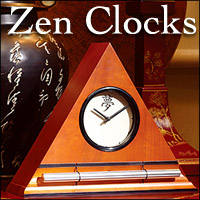 The beauty and functionality of the Zen Clock/Timer makes it a meditation tool that can actually help you "make time" for meditation in your life. Bring yourself back to balance. 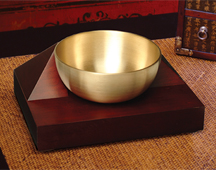 It features a long-resonating acoustic chime that brings your meditation or yoga session to a gradual close, preserving the environment of stillness while also acting as an effective time signal. Now & Zen – The Meditation Timer Shop
1638 Pearl Street
Boulder, CO 80302
(800) 779-6383
orders@now-zen.com
Posted in intention, Meditation Timers, Meditation Tools, mindfulness practice
 20th Century Japanese Woodblock prints via Ukiyoe Gallery “The Daily Show” or Letterman, looming work deadlines, your fussy child, the neighbor’s barking dog, or any other reason you haven’t been getting enough shut-eye. Most adults require seven to eight hours of sleep each night, yet surveys suggest that many of us are getting far less. A growing body of research shows the consequences of chronic poor sleep, including impaired memory, lowered immunity, weight gain, and an increased risk of Type 2 diabetes.
The effects of inadequate sleep on your energy levels are even clearer: You have trouble waking up and getting through your day without the crutch of caffeine. On a physical level, a sound night’s sleep is crucial to keeping your mitochondria in good working order. Without it, your levels of blood sugar and stress hormones rise, slowing your metabolism and draining you of energy.
The Fix
“Good sleep depends on good waking,” says Dr. Rubin Naiman, sleep and dream medicine specialist and the author of “Healing Night.” “Try to do things during the day that get you excited and make you feel passionate.” Staying engaged and alert while you’re awake makes you’re more likely to sleep hard and well at night. “Exposure to natural sunlight also helps regulate your sleep/wake cycle,” he says. In fact, a recent study in the journal “Sleep” found that the natural light provided by simply sitting near a window for 30 minutes can boost afternoon energy and decrease daytime sleepiness.
As bedtime nears, dim your lights to simulate dusk, which helps your body wind down naturally. Set your Zen Alarm Clock so that you can anticipate waking gently to soothing chimes. It’s also a good idea to limit stimulating activities (such as watching television) a few hours before bed. A hot bath infused with lavender oil and Epsom salts can also be profoundly relaxing. The lavender acts as a gentle sedative; the magnesium-rich salts relax tense muscles; and after a hot soak, your body temperature drops, encouraging sleepiness.
Still tired during the day? Your preschool teacher was on to something. Unless you suffer from insomnia, schedule a 10- to 15-minute afternoon rest, says Naiman. Don’t fret if you can’t nod off: What’s important is that you recognize and honor your body’s innate rhythms, which govern energy. Just a short period of rest, such as a meditation break during your lunch hour, can make a difference in your energy levels.
adapted from Body + Soul, September 2006
Waking up in the morning should be as pleasant as falling asleep at night. The Zen Alarm Clock’s gradual, gentle awakening is transformative.
 Chime Alarm Clocks for a Gentle, Progressive Awakening
Boulder, Colorado—an innovative company has taken one of life’s most unpleasant experiences (being startled awake by your alarm clock early Monday morning), and transformed it into something to actually look forward to.
“The Zen Alarm Clock,” uses soothing acoustic chimes that awaken users gently and gradually, making waking up a real pleasure. Rather than an artificial recorded sound played through a speaker, the Zen Clock features an alloy chime bar similar to a wind chime. When the clock’s alarm is triggered, its chime produces a long-resonating, beautiful acoustic tone reminiscent of a temple gong. Then, as the ring tone gradually fades away, the clock remains silent until it automatically strikes again three minutes later.
 Maple Dream Kanji Zen Alarm Clock, progressive chime alarm clock
Now & Zen’s Chime Alarm Clock Shop
1638 Pearl Street
Boulder, CO 80302
Posted in Bamboo Chime Clocks, Chime Alarm Clocks, intention
 Once you experience the Zen Timepiece's progressive tones, you'll never want to meditate any other way. This simple yet profound meditation can ease emotional or physical tension.
Based on Taoist Meditation practice, the inner smile meditation is a simple yet profound meditation that is quite natural to many people. It is centered on generating the benevolent qualities of a genuine smile that we usually offer to others. The inner smile is an opportunity to offer a smile to oneself. It can be done in a seated meditation session or in the midst of daily life. The inner smile can also be integrated into hatha yoga practice and can be particularly helpful during intense poses.
To begin, find a comfortable posture for meditation (seated on a cushion or blanket, in a chair, or against a wall). It may be helpful to set a timer for 10, 20, or 30 minutes so you can sink deeply into your meditation without wondering about the time. You may also want to gently ring a bell at the beginning and end of your meditation.
Place your hands on your knees in Jnana Mudra (index and thumb touching), with palms facing up to open your awareness or palms facing down to calm the mind. Do a body scan and relax any tension you may be holding. Let your spine rise from the root of the pelvis. Draw your chin slightly down and lengthen the back of your neck.
Meditation Practice
Begin by generating a feeling of natural happiness as if it emanates from the backs of the eyes. This may happen naturally or it may take you awhile to drop into the poetic possibility needed to allow a smile to come from the backs of your eyes. If the feeling does not come immediately, remind yourself of any experience of natural joy-for example, the face of a joyous child.
Once you generate the feeling of this smile, let it radiate down the backs of your eyes like a waterfall. Visualize this meditative stream flowing down the center of your spine, to your heart and lungs, then into your stomach and spleen (under your left lower ribs), and liver (under your right lower ribs). Let it run down through the kidneys (back ribs), the colon and intestines (belly), down into your genitals, and out into your legs and feet. You can repeat the sweep from the backs of the eyes to the feet or do one long, slow sweep. The inner smile can be its own complete meditation or it may lead you into an effortless meditative absorption.
When you are ready, bring your hands together in Anjali Mudra (Salutation Seal) and complete your meditation with a moment of gratitude, reflection, or prayer to seal the energy of your meditation into your life. Remember that you can cultivate the inner smile anytime throughout the day to fill the heart with compassion.
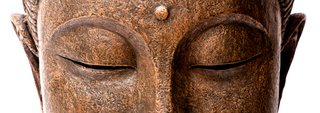 It serves as the perfect meditation timer. Use our unique “Zen Clock” which functions as a Yoga & Meditation Timer. It features a long-resonating acoustic chime that brings your meditation or yoga session to a gradual close, preserving the environment of stillness while also acting as an effective time signal. Our Yoga Timer & Clock can be programmed to chime at the end of the meditation or yoga session or periodically throughout the session as a kind of sonic yantra. The beauty and functionality of the Zen Clock/Timer makes it a meditation tool that can actually help you “make time” for meditation in your life. Bring yourself back to balance.
adapted from yogajournal.com by Shiva Rea
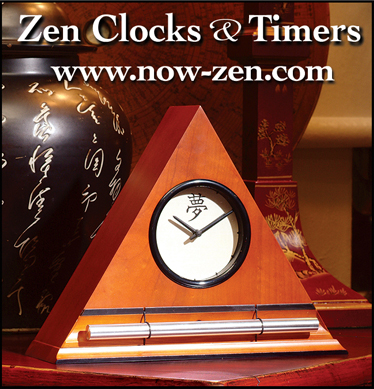 It's exquisite sounds summon your consciousness out of your meditative state with a series of subtle gongs. Now & Zen – The Meditation Timer Shop
1638 Pearl Street
Boulder, CO 80302
(800) 779-6383
orders@now-zen.com
Posted in intention, Meditation Timers, Meditation Tools, mindfulness practice
« Previous Page — « Previous Entries
Next Entries » — Next Page »
|
|
|
|